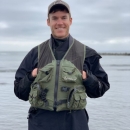Bull Trout (Salvelinus confluentus) were last documented in the Clackamas River in 1963. Over four decades later, a 2007 feasibility study determined the Clackamas River Subbasin to be a promising candidate for Bull Trout reintroduction. In 2011, the first phase of a multi-agency reintroduction effort began, with the overall goal of re-establishing a self-sustaining population of spawning adults by the year 2030. Releases of translocated Bull Trout from the Metolius River Subbasin to the upper Clackamas River and select tributaries began in 2011 and continued through 2016. The primary objectives during the twelfth year of the project (second phase) were to monitor and evaluate the reintroduction effort. After multiple years of navigating the lingering impacts associated with the COVID-19 global pandemic and road access issues resulting from wide-ranging 2020 forest fires, we made progress toward the project’s goal during 2022. Bull Trout reproduction, movement, seasonal distribution and the potential impacts to Endangered Species Act-listed salmon and Steelhead (Oncorhynchus mykiss) in the subbasin were assessed. A video monitoring weir with an adult trap and passive integrated transponder (PIT) antennas were employed to assess the spawning population in Pinhead Creek. A total of 36 individual Bull Trout were captured or observed while moving upstream of the weir, of which 28 (78%) were female and 8 (22%) were male. Ten (36%) females and six (75%) of the males possessed PIT tags. PIT-tagged individuals were translocated fish that had been released as juveniles and subadults in 2012 – 2016, confirming their survival and recruitment into the spawning adult population. Thirteen migratory fish, ranging in size from 495 – 810 mm in total length, were subsampled at the weir trap, of which eight were female and five were male. Five of the females and all five of the males captured were previously PIT-tagged. The three smallest females were untagged and tissue samples were collected for genetic analysis. Since all translocated fish were PIT-tagged, the presence of untagged fish may suggest a portion of the spawners were born locally. Despite 64% of the females lacking PIT tags, the low percentage of untagged males suggests recruitment of locally-born individuals into the Pinhead Creek spawning population may be low. However, seven small (300 – 400 mm TL), untagged Bull Trout adults moved through the weir video chute, supporting the possibility of natural recruitment into the spawning population. Redd counts increased to a high of 89 during 2017 but declined to 24 in 2022. Twenty-seven tissue samples from untagged fish collected at the weir trap from 2017 – 2022 were submitted for parentage analysis and to confirm the recruitment of locally-born progeny into the spawning population. Recently instituted monthly eDNA sampling in Pinhead Creek throughout Bull Trout spawning and early rearing areas will help to further describe temporal and spatial occupancy of Bull Trout in Pinhead Creek. Results will be compared with monthly eDNA samples from control (Cougar and Jack) creeks to determine how occupancy patterns are related to instream hatch and post-hatch periods. Thus far, monitoring efforts have not provided definitive evidence of locally-born post-emergent juveniles, or recruitment into the spawning population, both of which are major benchmarks for the reintroduction effort. Implementation and monitoring of the reintroduction project will continue in 2023 and the reintroduction strategy will be evaluated annually and adaptively managed.
Publication date
Type of document
Annual Report
Facility
Program
Species
FWS Focus
FWS and DOI Region(s)






